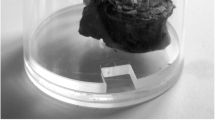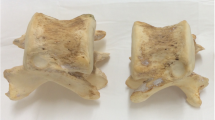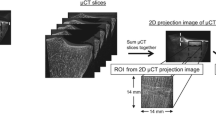Abstract:
The aim of the present study on human vertebral cancellous bone was to validate structural parameters measured with high-resolution (150 μm) computed tomography (HRCT) by referring to histomorphometry and to try to predict mechanical properties of bone using HRCT. Two adjacent vertical cores were removed from the central part of human L2 vertebral body taken after necropsy in 22 subjects aged 47–95 years (10 women, 12 men; mean age 79 ± 14 years). The right core was used for structural analysis performed by both HRCT and histomorphometry. Two cancellous bone specimens were extracted from the left core: a cube for HRCT and a compression test, and a cylinder for a shear test. Significant correlations were found between HRCT and histomorphometric measurements (BV/TV, trabecular thickness, separation and number, and node-strut analysis), but with higher values for most of the tomographic parameters (BV/TV and trabecular thickness determined by HRCT were overestimated by a factor 3.5 and 2.5 respectively, as compared with histomorphometry). The maximum compressive strength and Young’s modulus were highly correlated (ρ= 0.99, p<0.0005). Significant correlation was obtained between bone mineral density (determined using dual-energy X-ray absorptiometry) and the maximum compressive strength (ρ= 0.64, p= 0.002). In addition the maximum compressive strength and architectural parameters determined by HRCT or histomorphometry showed significant correlations (e.g., for HRCT, BV/TV: ρ = 0.88, p<0.0005, N.Nd/TV: ρ= 0.73, p<0.001). The shear strength was significantly correlated with BV/TV (ρ= 0.62, p= 0.002), Tb.Sp (ρ=−0.58, p= 0.004) and TSL (ρ= 0.55, p= 0.006) measured by HRCT. In conclusion, an HRCT system with 150 μm resolution is not sufficient to predict the true values of the structural parameters measured by histomorphometry, although high correlations were found between the two methods. However, we showed that a resolution of 150 μm allowed us to predict the mechanical properties of human cancellous bone. In vivo peripheral systems with such a resolution should be of interest and would deliver an acceptable radiation dose to the patient.
Similar content being viewed by others
Author information
Authors and Affiliations
Additional information
Received: 13 October 1998 / Accepted: 16 March 1999
Rights and permissions
About this article
Cite this article
Cendre, E., Mitton, D., Roux, JP. et al. High-Resolution Computed Tomography for Architectural Characterization of Human Lumbar Cancellous Bone: Relationships with Histomorphometry and Biomechanics . Osteoporos Int 10, 353–360 (1999). https://doi.org/10.1007/s001980050240
Issue Date:
DOI: https://doi.org/10.1007/s001980050240




